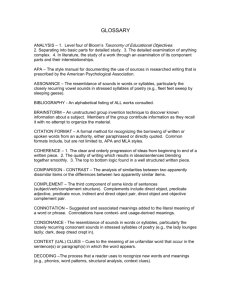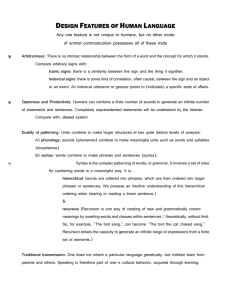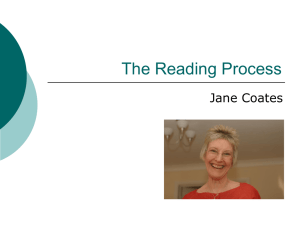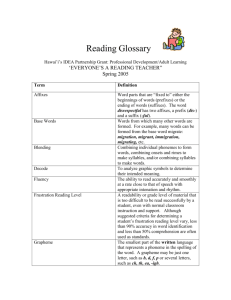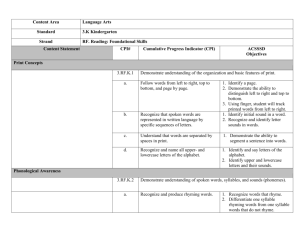ELD Glossary
advertisement
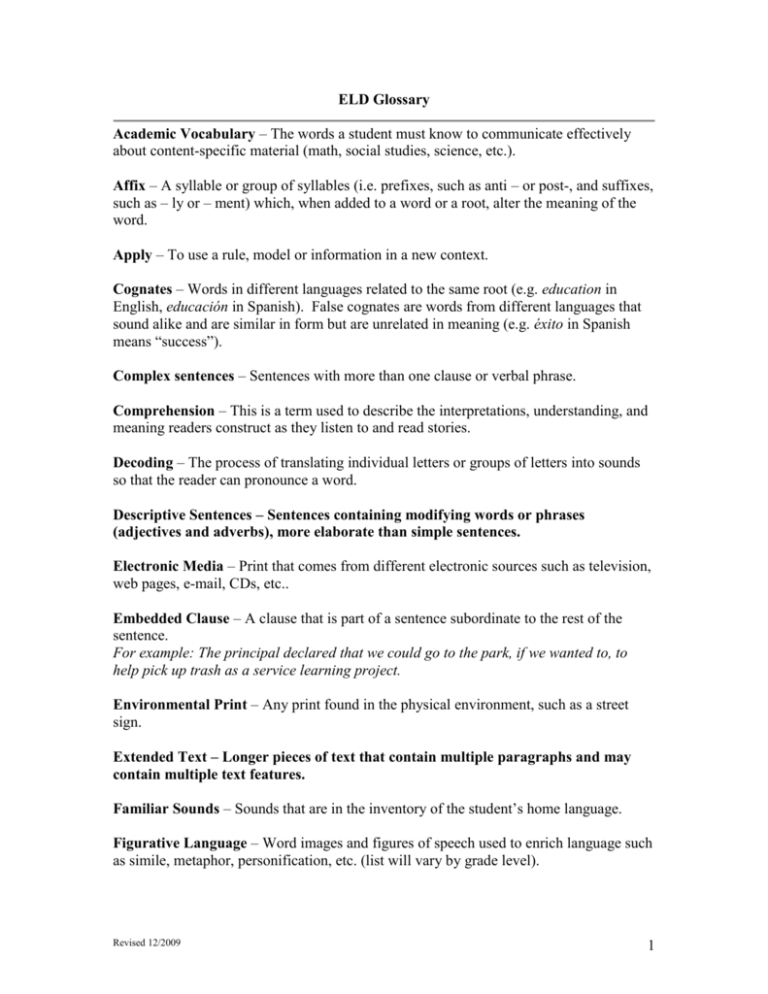
ELD Glossary Academic Vocabulary – The words a student must know to communicate effectively about content-specific material (math, social studies, science, etc.). Affix – A syllable or group of syllables (i.e. prefixes, such as anti – or post-, and suffixes, such as – ly or – ment) which, when added to a word or a root, alter the meaning of the word. Apply – To use a rule, model or information in a new context. Cognates – Words in different languages related to the same root (e.g. education in English, educación in Spanish). False cognates are words from different languages that sound alike and are similar in form but are unrelated in meaning (e.g. éxito in Spanish means “success”). Complex sentences – Sentences with more than one clause or verbal phrase. Comprehension – This is a term used to describe the interpretations, understanding, and meaning readers construct as they listen to and read stories. Decoding – The process of translating individual letters or groups of letters into sounds so that the reader can pronounce a word. Descriptive Sentences – Sentences containing modifying words or phrases (adjectives and adverbs), more elaborate than simple sentences. Electronic Media – Print that comes from different electronic sources such as television, web pages, e-mail, CDs, etc.. Embedded Clause – A clause that is part of a sentence subordinate to the rest of the sentence. For example: The principal declared that we could go to the park, if we wanted to, to help pick up trash as a service learning project. Environmental Print – Any print found in the physical environment, such as a street sign. Extended Text – Longer pieces of text that contain multiple paragraphs and may contain multiple text features. Familiar Sounds – Sounds that are in the inventory of the student’s home language. Figurative Language – Word images and figures of speech used to enrich language such as simile, metaphor, personification, etc. (list will vary by grade level). Revised 12/2009 1 Fluency – Ability to read a text quickly with accuracy and expression; freedom from word identification problems that might hinder comprehension in silent reading or the expression of ideas in oral reading; automaticity. Genres – A term used to classify literary and informational works into categories, such as biography, mystery, historical fictions, etc. (list will vary by grade level) Gestures – Movements made to initiate, clarify or enhance communication. Graphic Features – Features that illustrate information in text such as graphs, charts, maps, diagrams, tables, etc. Graphic Organizers – Organizers that provide a visual representation of facts and concepts from a text and their relationships within an organized frame. High Frequency Words – High utility words which make up 50% of printed text. For example: A, the, this, that, (Tim) Identify - A response behavior which requires neither verbalization nor writing. Idiom – An expression that does not mean what it literally says (e.g. you drive me crazy, hit the deck). Inferences – A specific conclusion reached using past knowledge and experience with text evidence. Inflectional Endings – A letter or group of letters which when added to the end of a word does not change its part of speech, but adjusts the word to fit the meaning of the sentence. For instance, girl, girls, jump, jumped, big, bigger, and so on. Instructional Level – The level at which the student can make maximum progress in reading with teacher guidance. The accuracy with which the student reads is 90-94%. Intonation – Differences in pitch that change the mood or function of a statement (e.g. Now. Now! Now?). Does not refer to differences in tone that are part of the phonological system of some languages. Invented Spelling – Invented Spelling- Temporary, incorrect spellings that reflect a writer's current knowledge of the English Spelling system. Spelling inventions provide valuable information about a student's perceptions on how words work. Language Production – Language production is speaking and writing language. Second language acquisition progresses through stages of production: active/receptive, concrete/functional, related/unified, conceptual/purposeful, and creative generation/problem solving. Revised 12/2009 2 Literal (link with inferential) – Meaning based on the actual words in their ordinary meaning; not figurative, idiomatic, or symbolic. Literary Devices – Techniques used to convey or enhance an author’s message or voice such as, idiom, figurative language, metaphor, exaggeration, dialogue, and imagery. (list will vary by grade level) Modals – Used to describe verbs and auxiliary verbs expressing a grammatical mood, for example, possibility or necessity (will, shall, can, could, should, might, may, and ought to). Modulation – The adjustment of the tone, pitch, or volume of the human voice. Monitoring Strategies – Strategies that readers use to “fix-up” the problems they encounter in comprehension. Readers who monitor their comprehension know when they understand what they read and when they do not, and are able to use the appropriate strategy in order to comprehend. Nonverbal Communication – Messages sent by way of gestures and other body language, and drawings. Onset and Rime – The initial consonant (s) sound of a syllable (the onset of a bag is b-; of swim, is sw-). A rime is a part of the syllable that contains the vowel and all that follows it (the rime of a bag is –ag; of swim, -im). Not all syllables or words have an onset, but they all have a rime (e.g., the word or syllable “out” is a rime without an onset) Organizational Structures – The organization of a text. (See Text Forms and Features) Persuasive devices – A technique the author uses to move the reader to his/her point of view such as bias, over generalization, and association Phonemes – The smallest unit of sound in spoken language Phonemic Awareness – The ability to hear; identify, and manipulate individual sounds (phonemes) in spoken words. Phonics – The understanding that there is a predictable relationship between phonemes (the sounds of spoken language) and graphemes (the letters and spellings that represent those sounds in written language). Phonological Awareness – A general understanding of the sound structure of words, including rhymes, syllables, and phonemes. Phrases – Two or more words expressed together that do not form a complete sentence. Picture Dictionary – A dictionary with pictures and graphics. Revised 12/2009 3 Pitch – The tone of the voice (high or low). Prefixes – An affix attached before a base word or root, as re – in reprint. Prompt – picture(s) or word(s) (written or oral) to which a student responds orally or in writing. Read-aloud Text – Text above the student’s independent reading level that the teacher or another student reads orally. Reference Tools – Materials for students to refer to in order to check spelling, word meaning, grammar, etc. Such as picture dictionaries and/or bilingual dictionaries. Root Words – Meaningful base form of a complex word, after all affixes are removed. Note: a root may be independent, or free, as read in unreadable, or may be dependent, or bound, as-liter- (from the Greek for letter) in illiterate. Scaffolding – providing a temporary framework for the student who is working just beyond her/his independent capabilities, i.e., sharing the cognitive workload to link the known to the unknown. Self-correction – student recognizes and corrects error without input from others. Sight words – Words that cannot be decoded and must be memorized and recognized at sight. Simple Literary Text – Short text made of simple sentences. Simple Sentences – Single clause sentences in active affirmative present tense. Story Elements – The critical parts of a story include character, setting, plot, problem, solution. At upper grades the terms problem and solution change to conflict and resolution. Suffixes – An affix attached to the end of a base, root, or stems that changes meaning or grammatical function of the word, as – ly added to happy to form happily. Summary – A synthesis of the important ideas in a text presented in a condensed form. Syllabication – Division of words into syllables. A syllable is a word part that contains a vowel, or in spoken language a vowel sound (e-vent; news – pa-per; ver-y). Syntax – The grammatical structure of language; The order in which words and inflections combine to convey meaning. The syntax of ELL students is developmental. Revised 12/2009 4 While English syntax is emerging, it will reflect the syntax of student’s primary language. Text Features – A prominent characteristic of a particular type of text such as chapter titles, sub-headings and bold faced words in a history text. Unfamiliar Sound – A sound that is not represented in the student’s primary language. Word Families – A collection of words that share common orthographic rimes such as thank, hank, dank. Revised 12/2009 5
